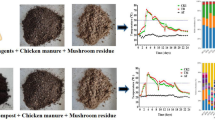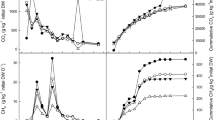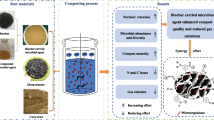Abstract
Due to the rapid development of animal husbandry, the associated environmental problems cannot be ignored, with the management of livestock and poultry manure emerging as the most prominent issue. Composting technology has been widely used in livestock and poultry manure management. A deeper understanding of the nitrogen conversion process during composting offers a theoretical foundation for selecting compost substrates. In this study, the effects of sawdust (CK) and spent mushroom compost (T1) as auxiliary materials on nitrogen as well as microbial structure in the composting process when composted with chicken manure were investigated. At the end of composting, the nitrogen loss of T1 was reduced by 17.18% relative to CK. When used as a compost substrate, spent mushroom compost accelerates the succession of microbial communities within the compost pile and alters the core microbial communities within the microbial community. Bacterial genera capable of cellulose degradation (Fibrobacter, Herbinix) are new core microorganisms that influence the assimilation of nitrate reduction during compost maturation. Using spent mushroom compost as a composting substrate increased the enzyme activity of nitrogen assimilation while decreasing the enzyme activity of the denitrification pathway.





Similar content being viewed by others
Data availability
The data and material of this manuscript are available.
References
Agarwal A, Mhatre A, Pandit R, Lali AM (2020) Synergistic biorefinery of Scenedesmus obliquus and Ulva lactuca in poultry manure towards sustainable bioproduct generation. Bioresour Technol 297:122462. https://doi.org/10.1016/j.biortech.2019.122462
Bolyen E, Rideout JR, Dillon MR et al (2019) Reproducible, interactive, scalable and extensible microbiome data science using QIIME 2. Nat Biotechnol 37:852–857. https://doi.org/10.1038/s41587-019-0209-9
Cáceres R, Malińska K, Marfà O (2018) Nitrification within composting: a review. Waste Manage 72:119–137. https://doi.org/10.1016/j.wasman.2017.10.049
Cao Y, Wang X, Liu L et al (2020) Acidification of manure reduces gaseous emissions and nutrient losses from subsequent composting process. J Environ Manage 264:110454. https://doi.org/10.1016/j.jenvman.2020.110454
Cayetano RDA, Park J, Kim G-B et al (2021) Enhanced anaerobic digestion of waste-activated sludge via bioaugmentation strategy—phylogenetic investigation of communities by reconstruction of unobserved states (PICRUSt2) analysis through hydrolytic enzymes and possible linkage to system performance. Bioresour Technol 332:125014. https://doi.org/10.1016/j.biortech.2021.125014
Chan MT, Selvam A, Wong JWC (2016) Reducing nitrogen loss and salinity during ‘struvite’ food waste composting by zeolite amendment. Bioresour Technol 200:838–844. https://doi.org/10.1016/j.biortech.2015.10.093
Che J, Bai Y, Li X et al (2021) Linking microbial community structure with molecular composition of dissolved organic matter during an industrial-scale composting. J Hazard Mater 405:124281. https://doi.org/10.1016/j.jhazmat.2020.124281
Chen H, Awasthi SK, Liu T et al (2020) Effects of microbial culture and chicken manure biochar on compost maturity and greenhouse gas emissions during chicken manure composting. J Hazard Mater 389:121908. https://doi.org/10.1016/j.jhazmat.2019.121908
Chen P, Cheng W, Li S (2023) Optimization strategies for mitigating nitrogen loss in the aerobic composting of pig manure and microbial changes revealed by metagenomic analysis. Process Saf Environ Prot 169:270–284. https://doi.org/10.1016/j.psep.2022.11.014
Chung WJ, Chang SW, Chaudhary DK et al (2021) Effect of biochar amendment on compost quality, gaseous emissions and pathogen reduction during in-vessel composting of chicken manure. Chemosphere 283:131129. https://doi.org/10.1016/j.chemosphere.2021.131129
Cui E, Wu Y, Zuo Y, Chen H (2016) Effect of different biochars on antibiotic resistance genes and bacterial community during chicken manure composting. Bioresour Technol 203:11–17. https://doi.org/10.1016/j.biortech.2015.12.030
de Guardia A, Mallard P, Teglia C et al (2010) Comparison of five organic wastes regarding their behaviour during composting: part 2, nitrogen dynamic. Waste Manage 30:415–425. https://doi.org/10.1016/j.wasman.2009.10.018
Douglas GM, Maffei VJ, Zaneveld JR et al (2020) PICRUSt2 for prediction of metagenome functions. Nat Biotechnol 38:685–688. https://doi.org/10.1038/s41587-020-0548-6
Duan Y, Awasthi SK, Chen H et al (2019) Evaluating the impact of bamboo biochar on the fungal community succession during chicken manure composting. Bioresour Technol 272:308–314. https://doi.org/10.1016/j.biortech.2018.10.045
Gao X, Xu Z, Li Y et al (2021) Bacterial dynamics for gaseous emission and humification in bio-augmented composting of kitchen waste. Sci Total Environ 801:149640. https://doi.org/10.1016/j.scitotenv.2021.149640
Georges M, Charlier C, Hayes B (2019) Harnessing genomic information for livestock improvement. Nat Rev Genet 20:135–156. https://doi.org/10.1038/s41576-018-0082-2
Huang B, Wang J, Han X et al (2022) The relationship between material transformation, microbial community and amino acids and alkaloid metabolites in the mushroom residue-prickly ash seed oil meal composting with biocontrol agent addition. Bioresour Technol 350:126913. https://doi.org/10.1016/j.biortech.2022.126913
Kong Z, Wang M, Shi X et al (2022) The functions of potential intermediates and fungal communities involved in the humus formation of different materials at the thermophilic phase. Bioresour Technol 354:127216. https://doi.org/10.1016/j.biortech.2022.127216
Lee J-C, Kim Y-S, Yun B-S, Whang K-S (2015) Idiomarina halophila sp. nov., isolated from a solar saltern sediment. Int J Syst Evol Microbiol 65:1268–1273. https://doi.org/10.1099/ijs.0.000094
Li M-T, Rao L, Wang L et al (2022) Bioaugmentation with syntrophic volatile fatty acids-oxidizing consortia to alleviate the ammonia inhibition in continuously anaerobic digestion of municipal sludge. Chemosphere 288:132389. https://doi.org/10.1016/j.chemosphere.2021.132389
Li S, Li D, Li J et al (2018) Effect of spent mushroom substrate as a bulking agent on gaseous emissions and compost quality during pig manure composting. Environ Sci Pollut Res 25:12398–12406. https://doi.org/10.1007/s11356-018-1450-3
Liu L, Wang S, Guo X et al (2018) Succession and diversity of microorganisms and their association with physicochemical properties during green waste thermophilic composting. Waste Manage 73:101–112. https://doi.org/10.1016/j.wasman.2017.12.026
Ma J, Chen F, Xue S et al (2021) Improving anaerobic digestion of chicken manure under optimized biochar supplementation strategies. Bioresour Technol 325:124697. https://doi.org/10.1016/j.biortech.2021.124697
Manu MK, Wang C, Li D et al (2021) Biodegradation kinetics of ammonium enriched food waste digestate compost with biochar amendment. Bioresour Technol 341:125871. https://doi.org/10.1016/j.biortech.2021.125871
Meng L, Li W, Zhang S et al (2021) Improving sewage sludge compost process and quality by carbon sources addition. Sci Rep 11:1319. https://doi.org/10.1038/s41598-020-79443-3
Neumann AP, Suen G (2018) The phylogenomic diversity of herbivore-associated Fibrobacter spp. is correlated to lignocellulose-degrading potential. mSphere 3. https://doi.org/10.1128/mSphere.00593-18
Petric I, Šestan A, Šestan I (2009) Influence of wheat straw addition on composting of poultry manure. Process Saf Environ Prot 87:206–212
Porter NT, Luis AS, Martens EC (2018) Bacteroides thetaiotaomicron. Trends Microbiol 26:966–967. https://doi.org/10.1016/j.tim.2018.08.005
Sharma D, Yadav KD, Kumar S (2018) Role of sawdust and cow dung on compost maturity during rotary drum composting of flower waste. Bioresour Technol 264:285–289. https://doi.org/10.1016/j.biortech.2018.05.091
Shen Y, Ren L, Li G et al (2011) Influence of aeration on CH4, N2O and NH3 emissions during aerobic composting of a chicken manure and high C/N waste mixture. Waste Manage 31:33–38. https://doi.org/10.1016/j.wasman.2010.08.019
Silva ME, Lemos LT, Cunha-Queda AC, Nunes OC (2009) Co-composting of poultry manure with low quantities of carbon-rich materials. Waste Manage Res J Sustain Circ Econ 27:119–128. https://doi.org/10.1177/0734242X08096693
Sohail M, Khan A, Badshah M et al (2022) Yak rumen fluid inoculum increases biogas production from sheep manure substrate. Bioresour Technol 362:127801. https://doi.org/10.1016/j.biortech.2022.127801
Thompson W, Leege P, Millner P, Watson ME (2003) Test methods for the examination of composts and composting. The US Composting Council, US Government Printing Office
Tian B, Pan Y, Wang J, et al (2022) Insoluble dietary fibers from by-products of edible fungi industry: basic structure, physicochemical properties, and their effects on energy intake. Front Nutr 9. https://doi.org/10.3389/fnut.2022.851228
Tsavkelova E, Prokudina L, Egorova M et al (2018) The structure of the anaerobic thermophilic microbial community for the bioconversion of the cellulose-containing substrates into biogas. Process Biochem 66:183–196. https://doi.org/10.1016/j.procbio.2017.12.006
Wainaina S, Awasthi MK, Sarsaiya S et al (2020) Resource recovery and circular economy from organic solid waste using aerobic and anaerobic digestion technologies. Bioresour Technol 301:122778. https://doi.org/10.1016/j.biortech.2020.122778
Wang B, Yan J, Li G et al (2021) The addition of bean curd dreg improved the quality of mixed cow manure and corn stalk composting: enhancing the maturity and improving the micro-ecological environment. Environ Sci Pollut Res 28:27095–27108. https://doi.org/10.1007/s11356-021-12572-y
Wang C et al (2022a) Bacterial dynamics and functions driven by a novel microbial agent to promote kitchen waste composting and reduce environmental burden. J Clean Prod 337:130491. https://doi.org/10.1016/j.jclepro.2022.130491
Wang H, Guo L, Ren X et al (2022b) Enhanced aerobic granular sludge by static magnetic field to treat saline wastewater via simultaneous partial nitrification and denitrification (SPND) process. Bioresour Technol 350:126891. https://doi.org/10.1016/j.biortech.2022.126891
Wang S-P, Wang L, Sun Z-Y et al (2022d) Effect of distillery sewage sludge addition on performance and bacterial community dynamics during distilled grain waste composting. Bioresour Technol 345:126486. https://doi.org/10.1016/j.biortech.2021.126486
Wang X, Ya T, Zhang M et al (2019) Cadmium (II) alters the microbial community structure and molecular ecological network in activated sludge system. Environ Pollut 255:113225. https://doi.org/10.1016/j.envpol.2019.113225
Xu M, Sun H, Yang M et al (2023) Effect of biodrying of lignocellulosic biomass on humification and microbial diversity. Bioresour Technol 384:129336. https://doi.org/10.1016/j.biortech.2023.129336
Xu Z, Xu W, Zhang L et al (2021) Bacterial dynamics and functions driven by bulking agents to mitigate gaseous emissions in kitchen waste composting. Bioresour Technol 332:125028. https://doi.org/10.1016/j.biortech.2021.125028
Yang Y, Kumar Awasthi M, Du W et al (2020) Compost supplementation with nitrogen loss and greenhouse gas emissions during pig manure composting. Bioresour Technol 297:122435. https://doi.org/10.1016/j.biortech.2019.122435
Yu C, Li M, Zhang B et al (2022) Hydrothermal pretreatment contributes to accelerate maturity during the composting of lignocellulosic solid wastes. Bioresour Technol 346:126587. https://doi.org/10.1016/j.biortech.2021.126587
Yu K, Li S, Sun X, Kang Y (2020) Maintaining the ratio of hydrosoluble carbon and hydrosoluble nitrogen within the optimal range to accelerate green waste composting. Waste Manage 105:405–413. https://doi.org/10.1016/j.wasman.2020.02.023
Zeng J, Price GW, Arnold P (2012) Evaluation of an aerobic composting process for the management of specified risk materials (SRM). J Hazard Mater 219–220:260–266. https://doi.org/10.1016/j.jhazmat.2012.04.003
Zhang H, Wang K, Shen L, et al (2018) Microbial community dynamics and assembly follow trajectories of an early-spring diatom bloom in a semienclosed bay. Appl Environ Microbiol 84. https://doi.org/10.1128/AEM.01000-18
Zhang L, Sun X (2016) Influence of bulking agents on physical, chemical, and microbiological properties during the two-stage composting of green waste. Waste Manage 48:115–126. https://doi.org/10.1016/j.wasman.2015.11.032
Zhang M-S, Li W, Zhang W-G et al (2021a) Agricultural land-use change exacerbates the dissemination of antibiotic resistance genes via surface runoffs in Lake Tai Basin China. Ecotoxicol Environ Saf 220:112328. https://doi.org/10.1016/j.ecoenv.2021.112328
Zhang W, Yu C, Wang X, Hai L (2020) Increased abundance of nitrogen transforming bacteria by higher C/N ratio reduces the total losses of N and C in chicken manure and corn stover mix composting. Bioresour Technol 297:122410. https://doi.org/10.1016/j.biortech.2019.122410
Zhang X, Li S, Cheng W et al (2021b) Oxytetracycline stress reconstruct the core microbial community related to nitrogen transformation during composting. Bioresour Technol 319:124142. https://doi.org/10.1016/j.biortech.2020.124142
Zhang Y, Xiao X, Elhag O et al (2022) Hermetia illucens L. larvae–associated intestinal microbes reduce the transmission risk of zoonotic pathogens in pig manure. Microb Biotechnol 15:2631–2644. https://doi.org/10.1111/1751-7915.14113
Zhang Y, Zhao Y, Chen Y et al (2016) A regulating method for reducing nitrogen loss based on enriched ammonia-oxidizing bacteria during composting. Bioresour Technol 221:276–283. https://doi.org/10.1016/j.biortech.2016.09.057
Zhang Z, Wei Z, Guo W et al (2021c) Two types nitrogen source supply adjusted interaction patterns of bacterial community to affect humifaction process of rice straw composting. Bioresour Technol 332:125129. https://doi.org/10.1016/j.biortech.2021.125129
Zhu L, Wei Z, Yang T et al (2020) Core microorganisms promote the transformation of DOM fractions with different molecular weights to improve the stability during composting. Bioresour Technol 299:122575. https://doi.org/10.1016/j.biortech.2019.122575
Zhu L, Yang H, Zhao Y et al (2019a) Biochar combined with montmorillonite amendments increase bioavailable organic nitrogen and reduce nitrogen loss during composting. Bioresour Technol 294:122224. https://doi.org/10.1016/j.biortech.2019.122224
Zhu L, Zhao Y, Zhang W, Zhou H, Chen X, Li Y, Wei D, Wei Z (2019b) Roles of bacterial community in the transformation of organic nitrogen toward enhanced bioavailability during composting with different wastes. Bioresour Technol 285:121326. https://doi.org/10.1016/j.biortech.2019.121326
Funding
This study was supported by the National Natural Science Foundation of China (Nos. 31772642, 31672457), the Ministry of Agricultural of the People’s Republic of China (2015-Z64, 2016-X47), the Hunan Provincial Science and Technology Department (2021JJ30008, 2019TP2004, 2017NK2322, 2016WK2008, 2016TP2005), the Double first-class construction project of Hunan Agricultural University (SYL201802003), the China Postdoctoral Science Foundation (2018M632963, 2019T120705), the Postgraduate Scientific Research Innovation Project of Hunan Province (CX20210654), and the Science and Technology Innovation and Entrepreneurship Project for University Students of Hunan Province (2021RC1004).
Author information
Authors and Affiliations
Contributions
JF and GL contributed to the study’s conception and design. XW, NL, HY, and RZ were responsible for research, material preparation, data collection, and analysis, and the first draft of the manuscript was written by XW. GL commented on previous versions of the manuscript. All aforementioned authors read and approved the final manuscript.
Corresponding author
Ethics declarations
Ethical approval
This experiment does not involve animal or human experiments, and the submission was approved by all authors.
Consent to participate
The development of the research work and the writing of the manuscript have been agreed and participated by all the authors.
Consent for publication
The manuscript was published with the consent of all the authors.
Competing interests
The authors declare no competing interests.
Additional information
Responsible Editor: Diane Purchase
Publisher's note
Springer Nature remains neutral with regard to jurisdictional claims in published maps and institutional affiliations.
Rights and permissions
Springer Nature or its licensor (e.g. a society or other partner) holds exclusive rights to this article under a publishing agreement with the author(s) or other rightsholder(s); author self-archiving of the accepted manuscript version of this article is solely governed by the terms of such publishing agreement and applicable law.
About this article
Cite this article
Wang, X., Liu, N., Zeng, R. et al. Change of core microorganisms and nitrogen conversion pathways in chicken manure composts by different substrates to reduce nitrogen losses. Environ Sci Pollut Res 31, 14959–14970 (2024). https://doi.org/10.1007/s11356-024-31901-5
Received:
Accepted:
Published:
Issue Date:
DOI: https://doi.org/10.1007/s11356-024-31901-5




